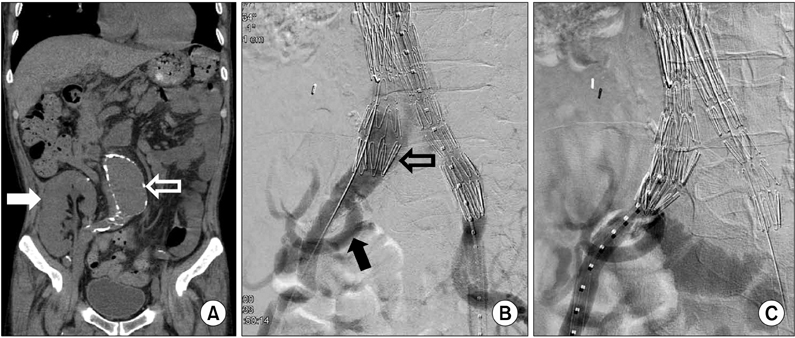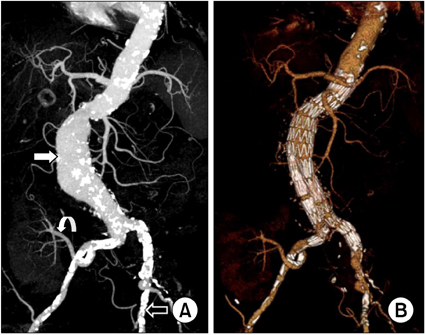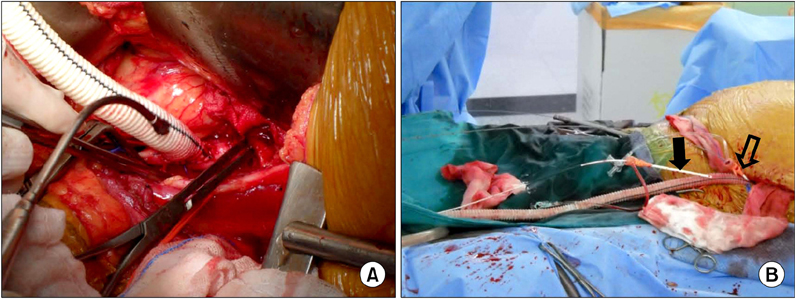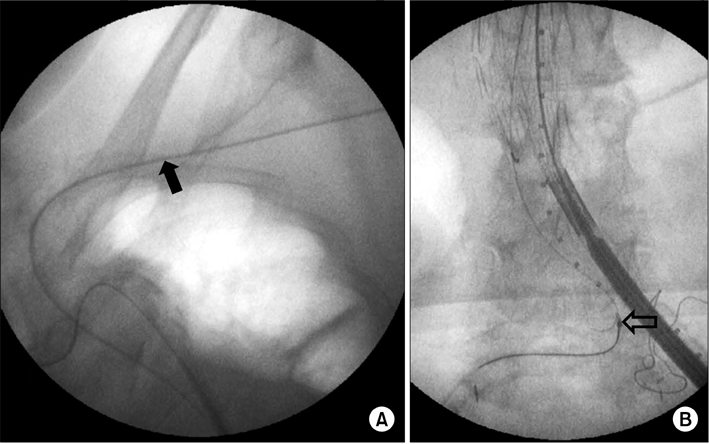J Korean Surg Soc.
2013 Mar;84(3):189-193.
Endovascular abdominal aortic aneurysm repair in patients with renal transplant
- Affiliations
-
- 1Department of Surgery, Kyung Hee University Hospital at Gangdong, Kyung Hee University School of Medicine, Seoul, Korea. jhjoh@khu.ac.kr
- 2Department of Radiology, Kyung Hee University Hospital at Gangdong, Kyung Hee University School of Medicine, Seoul, Korea.
Abstract
- The repair of abdominal aortic aneurysm (AAA) in patients with functioning renal transplant is critical because it is important to avoid ischemic and reperfusion injury to the transplanted kidney. Endovascular aneurysm repair (EVAR) avoids aortic cross clamping and can prevent renal graft ischemia. Here we report the endovascular management and outcome of AAA in two renal transplant patients using a bifurcated aortic stent graft. One patient underwent EVAR using a small amount of contrast (30 mL) due to decreased renal function resulting from chronic rejection. Another patient had EVAR performed with iliac conduit because of the heavily calcified, stenotic lesion of external iliac artery. EVAR in patients with a renal transplant is a feasible option without impairing renal arterial flow.
MeSH Terms
Figure
Reference
-
1. Karkos CD, McMahon G, Fishwick G, Lambert K, Bagga A, McCarthy MJ. Endovascular abdominal aortic aneurysm repair in the presence of a kidney transplant: therapeutic considerations. Cardiovasc Intervent Radiol. 2006. 29:284–288.2. Kim HK, Ryuk JP, Choi HH, Kwon SH, Huh S. Abdominal aortic aneurysm repair in patient with a renal allograft: a case report. J Korean Med Sci. 2009. 24:166–169.3. Machado R, Almeida P, Loureiro L, Almeida R. Renal transplantation after endovascular aortic aneurysm repair: case report and literature review. Transplant Proc. 2011. 43:150–152.4. Hseino H, McGrath F, Hickey D, Hill AD, Moneley D. Endovascular abdominal aortic aneurysm repair in kidney transplant recipients: case series. Surgeon. 2011. 9:115–117.5. Kaskarelis IS, Koukoulaki M, Lappas I, Karkatzia F, Dimopoulos N, Filias V, et al. Successful endovascular repair of ruptured abdominal aortic aneurysm in a renal transplant recipient. Cardiovasc Intervent Radiol. 2006. 29:279–283.6. Sawhney R, Chuter TA, Wall SD, Reilly LM, Kerlan RK, Canto CJ, et al. Aortic stent-grafts in patients with renal transplants. J Endovasc Ther. 2000. 7:286–291.7. Lacombe M. Surgical treatment of aortoiliac aneurysms in renal transplant patients. J Vasc Surg. 2008. 48:291–295.8. Leon LR Jr, Glazer ES, Hughes JD, Bui TD, Psalms SB, Goshima KR. Aortoiliac aneurysm repair in kidney transplant recipients. Vasc Endovascular Surg. 2009. 43:30–45.9. Roach DM, Thompson MM, Patrick GM, Fitridge RA. Aortic aneurysm repair with a functioning renal transplant: therapeutic options. ANZ J Surg. 2004. 74:65–67.10. Criado FJ. Iliac arterial conduits for endovascular access: technical considerations. J Endovasc Ther. 2007. 14:347–351.
- Full Text Links
- Actions
-
Cited
- CITED
-
- Close
- Share
- Similar articles
-
- Hybrid Treatment of Coexisting Renal Artery Aneurysm and Abdominal Aortic Aneurysm in a Gallbladder Cancer Patient
- Ruptured Abdominal Aortic Aneurysm with Antecedent Endovascular Repair of Abdominal Aortic Aneurysm
- A Case of Near Total Occlusion of the Renal Artery after Endovascular Abdominal Aortic Aneurysm Repair
- Hybrid Repair of Suprarenal Abdominal Aortic Aneurysm: Antegrade Debranching with Endovascular Aneurysm Repair
- Endovascular Repair of a Juxtarenal Abdominal Aortic Aneurysm Using a Chimney Graft





